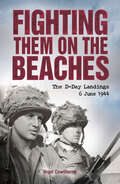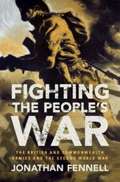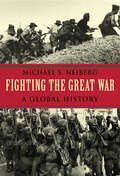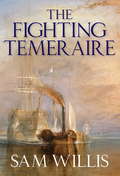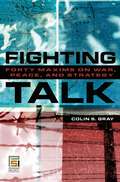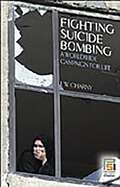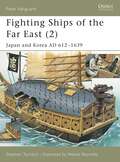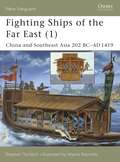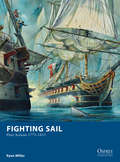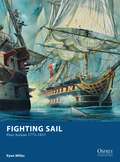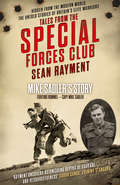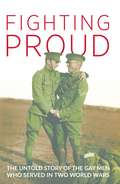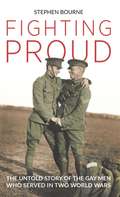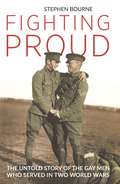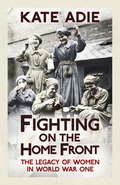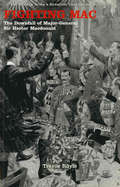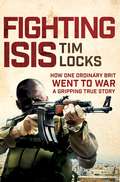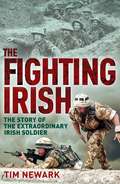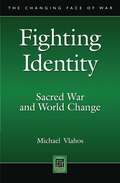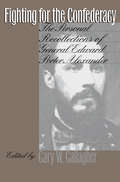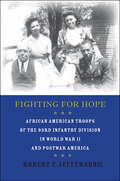- Table View
- List View
Fighting them on the Beaches: The D-Day Landings - June 6, 1944
by Nigel CawthorneThis book tells the story of Operation Overlord, the largest and most meticulously planned seaborne invasion in the history of warfare. As dawn broke on 6 June 1944, thousands of Allied soldiers - American, British, Canadian, Free French and Polish - hit the Normandy beaches and stormed the German defenses of the Atlantic Wall. By Midnight, over 150,000 troops had been safely landed, and the ling push towards Berlin and the final defeat of the Third Reich had begun.Including useful maps with troop movements, as well as an index of the armies, battles, campaigns and commanders, Fighting Them on the Beaches is a brilliant guide to this historic battle which turned the tide against Adolf Hitler.
Fighting the People's War: The British and Commonwealth Armies and the Second World War (PDF) (Armies Of The Second World War Ser.)
by Jonathan FennellFighting the People's War is an unprecedented, panoramic history of the 'citizen armies' of the United Kingdom, Australia, Canada, India, New Zealand and South Africa, the core of the British and Commonwealth armies in the Second World War. Drawing on new sources to reveal the true wartime experience of the ordinary rank and file, Jonathan Fennell fundamentally challenges our understanding of the War and of the relationship between conflict and socio-political change. He uncovers how fractures on the home front had profound implications for the performance of the British and Commonwealth armies and he traces how soldiers' political beliefs, many of which emerged as a consequence of their combat experience, proved instrumental to the socio-political changes of the postwar era. Fighting the People's War transforms our understanding of how the great battles were won and lost as well as how the postwar societies were forged.
Fighting the Great War: A Global History
by Michael S. NeibergDespair at Gallipoli. Victory at Vimy Ridge. A European generation lost, an American spirit found. The First World War, the deadly herald of a new era, continues to captivate readers. In this lively book, Michael Neiberg offers a concise history based on the latest research and insights into the soldiers, commanders, battles, and legacies of the Great War. Tracing the war from Verdun to Salonika to Baghdad to German East Africa, Neiberg illuminates the global nature of the conflict. More than four years of mindless slaughter in the trenches on the western front, World War I was the first fought in three dimensions: in the air, at sea, and through mechanized ground warfare. New weapons systems--tanks, bomber aircraft, and long-range artillery--all shaped the battle environment. Moving beyond the standard portrayal of the war's generals as "butchers and bunglers," Neiberg offers a nuanced discussion of officers constrained by the monumental scale of complex events. Diaries and letters of men serving on the front lines capture the personal stories and brutal conditions--from Alpine snows to Mesopotamian sands--under which these soldiers lived, fought, and died. Generously illustrated, with many never-before-published photographs, this book is an impressive blend of analysis and narrative. Anyone interested in understanding the twentieth century must begin with its first global conflict, and there is no better place to start than with Fighting the Great War.
The Fighting Temeraire: Legend of Trafalgar (Hearts of Oak Trilogy Vol.1) (Hearts of Oak Trilogy #1)
by Sam WillisJ.M.W. Turner's The Fighting Temeraire Tugged to her Last Berth to be Broken Up (1838) was his masterpiece. Sam Willis tells the real-life story behind this remarkable painting. The 98-gun Temeraire warship broke through the French and Spanish line directly astern of Nelson's flagship Victory during the Battle of Trafalgar (1805), saving Nelson at a crucial moment in the battle, and, in the words of John Ruskin, fought until her sides ran 'wet with the long runlets of English blood...those pale masts that stayed themselves up against the war-ruin, shaking out their ensigns through the thunder, till sail and ensign dropped.' It is a story that unites the art of war as practised by Nelson with the art of war as depicted by Turner and, as such, it ranges across an extensive period of Britain's cultural and military history in ways that other stories do not. The result is a detailed picture of British maritime power at two of its most significant peaks in the age of sail: the climaxes of both the Seven Years' War (1756-63) and the Napoleonic Wars (1798-1815). It covers every aspect of life in the sailing navy, with particular emphasis on amphibious warfare, disease, victualling, blockade, mutiny and, of course, fleet battle, for it was at Trafalgar that the Temeraire really won her fame. An evocative and magnificent narrative history by a master historian.
Fighting Talk: Forty Maxims on War, Peace, and Strategy (Praeger Security International)
by Colin S. GrayGray presents an inventive treatise on the nature of strategy, war, and peace, organized around forty maxims. This collection of mini-essays will forearm politicians, soldiers, and the attentive general public against many—probably most—fallacies that abound in contemporary debates about war, peace, and security. While one can never guarantee strategic success, which depends on policy, military prowess, and the quality of the dialogue between the two, a strategic education led by the judgments in these maxims increases the chances that one's errors will be small rather than catastrophic.The maxims are grouped according to five clusters. War and Peace tackles the larger issues of strategic history that drive the demand for the services of strategic thought and practice. Strategy presses further, into the realm of strategic behavior, and serves as a bridge between the political focus of part one and the military concerns that follow. In Military Power and Warfare turns to the pragmatic business of military performance: operations, tactics, and logistics. Part four, Security and Insecurity examines why strategy is important, including a discussion of the nature, dynamic character, and functioning of world politics. Finally, History and the Future is meant to help strategists better understand the processes of historical change.
Fighting Suicide Bombing: A Worldwide Campaign for Life (Praeger Security International)
by Israel W. CharnyHow does one effectively fight suicide bombers? What threat do they hold for Western society? How do people who love peace reconcile the need for war? Noted genocide expert Israel W. Charny addresses these questions in this highly personal description of suicide bombings and terror as the opening salvos of a Third World War. Charny first seeks to understand what makes suicide bombers tick, as well as the culture from which they emerge. Taking this understanding of what he calls human evil, he then proposes a hawkish campaign that ultimately emphasizes peace rather than irrational fear.By deeming suicide bombing and terrorism as necessary subjects in the study of psychology, Charny presents yet another weapon in the war against terrorism-a war that he believes will only escalate without drastic action. Ultimately, he calls for a worldwide campaign for life led by religious and secular leaders across the globe. He concludes the book with a vignette from Islamic culture that speaks nobly to furthering peace and life.
Fighting Ships of the Far East: Japan and Korea AD 612–1639 (New Vanguard #63)
by Stephen TurnbullOver the centuries, naval relations between Japan and Korea appear to have alternated between peaceful trade and outright hostility. However, this impression can be misleading, as much of what passed for mercantile activity was in fact conducted by Japanese pirate fleets, who pillaged the coasts of Korea and China in a long-lasting tradition that culminated in the greatest pirate raid of all: Hideyoshi's invasion of Korea in 1592. This was the conflict that involved Ming China and almost dragged in Siam. It also led to Korea developing East Asia's most famous warship: the legendary turtle ship, which is described for the first time in full technical detail in this book.
Fighting Ships of the Far East: Japan and Korea AD 612–1639 (New Vanguard)
by Stephen Turnbull Wayne ReynoldsOver the centuries, naval relations between Japan and Korea appear to have alternated between peaceful trade and outright hostility. However, this impression can be misleading, as much of what passed for mercantile activity was in fact conducted by Japanese pirate fleets, who pillaged the coasts of Korea and China in a long-lasting tradition that culminated in the greatest pirate raid of all: Hideyoshi's invasion of Korea in 1592. This was the conflict that involved Ming China and almost dragged in Siam. It also led to Korea developing East Asia's most famous warship: the legendary turtle ship, which is described for the first time in full technical detail in this book.
Fighting Ships of the Far East: China and Southeast Asia 202 BC–AD 1419 (New Vanguard)
by Stephen Turnbull Wayne ReynoldsFighting Ships of the Far East (1) adds enormously to the hitherto small corpus of knowledge about a fascinating and little known subject. Using detailed descriptions, accurate cutaway plates and reliable historical examples, this book covers the history of Chinese ship design and naval warfare from the beginning of the Han dynasty to the first few years of the Ming dynasty. The epic battle of Lake Poyang in in 1363, won by the man who was to become the first Ming Emperor, is also detailed.
Fighting Ships of the Far East: China and Southeast Asia 202 BC–AD 1419 (New Vanguard #61)
by Stephen Turnbull Wayne ReynoldsFighting Ships of the Far East (1) adds enormously to the hitherto small corpus of knowledge about a fascinating and little known subject. Using detailed descriptions, accurate cutaway plates and reliable historical examples, this book covers the history of Chinese ship design and naval warfare from the beginning of the Han dynasty to the first few years of the Ming dynasty. The epic battle of Lake Poyang in in 1363, won by the man who was to become the first Ming Emperor, is also detailed.
Fighting Sail: Fleet Actions 1775–1815 (Osprey Wargames #9)
by Ryan Miller Peter DennisIn the years between 1776 and 1815, grand square-rigged sailing ships dominated warfare on the high seas. Fighting Sail is a tabletop wargame of fleet battles in this age of canvas, cannon, and timbers. Players take on the roles of fleet admirals in battles ranging from the American War of Independence to the Napoleonic Wars and the War of 1812. Each fleet has access to different ships, tactics, and command personalities – each with its own strengths and weaknesses. Offering a unique blend of detail and simplicity, the scenarios included enable the recreation of historic actions or 'what-if' scenarios. Join the battle and experience the adventurous age of the fighting sail!
Fighting Sail: Fleet Actions 1775–1815 (Osprey Wargames)
by Ryan Miller Peter DennisIn the years between 1776 and 1815, grand square-rigged sailing ships dominated warfare on the high seas. Fighting Sail is a tabletop wargame of fleet battles in this age of canvas, cannon, and timbers. Players take on the roles of fleet admirals in battles ranging from the American War of Independence to the Napoleonic Wars and the War of 1812. Each fleet has access to different ships, tactics, and command personalities – each with its own strengths and weaknesses. Offering a unique blend of detail and simplicity, the scenarios included enable the recreation of historic actions or 'what-if' scenarios. Join the battle and experience the adventurous age of the fighting sail!
Fighting Rommel: Captain Mike Sadler (Tales from the Special Forces Shorts #1)
by Sean RaymentThis is Mike Sadler’s story, one of five true-life recollections from the Second World War in Tales From The Special Forces Club.
Fighting Proud: The Untold Story Of The Gay Men Who Served In Two World Wars (PDF)
by Stephen Bourne"In 1943 the famous Battle of Britain pilot Flight Lieutenant Ian Gleed was shot down over Tunisia. He died a hero. Twice before he had bailed out of blazing Spitfires. Twice King George VI had congratulated him. What his family probably never knew was that Gleed was homosexual. It was not until the 1990s, when one of his lovers was interviewed for BBC television, that the truth came out. . . " In this astonishing new history of wartime Britain, historian Stephen Bourne unearths the fascinating stories of the gay men who served in the armed forces and at home, and brings to light the great unheralded contribution they made to the war effort. Fighting Proud weaves together the remarkable lives of these men, from RAF hero Ian Gleed - a Flying Ace twice honored for bravery by King George VI - to the infantry officers serving in the trenches on the Western Front in WWI - many of whom led the charges into machine-gun fire only to find themselves court-marshalled after the war for indecent behavior. Behind the lines, Alan Turing's work on breaking the "enigma machine" and subsequent persecution contrasts with the many stories of love and courage in Blitzed-out London, with new wartime diaries and letters unearthed for the first time. Bourne tells the bitterly sad story of Ivor Novello, who wrote the WWI anthem "Keep the Home Fires Burning," and the crucial work of Noel Coward - who was hated by Hitler for his work entertaining the troops. Fighting Proud also includes a wealth of long-suppressed wartime photography subsequently ignored by mainstream historians. This book is a monument to the bravery, sacrifice and honor shown by a persecuted minority, who contributed during Britain's hour of need.
Fighting Proud: The Untold Story of the Gay Men Who Served in Two World Wars
by Stephen BourneIn this astonishing new history of wartime Britain, historian Stephen Bourne unearths the fascinating stories of the gay men who served in the armed forces and at home, and brings to light the great unheralded contribution they made to the war effort. Fighting Proud weaves together the remarkable lives of these men, from RAF hero Ian Gleed – a Flying Ace twice honoured for bravery by King George VI – to the infantry officers serving in the trenches on the Western Front in WWI - many of whom led the charges into machine-gun fire only to find themselves court-martialled after the war for indecent behaviour. Behind the lines, Alan Turing's work on breaking the 'enigma machine' and subsequent persecution contrasts with the many stories of love and courage in Blitzed-out London, with new wartime diaries and letters unearthed for the first time. Bourne tells the bitterly sad story of Ivor Novello, who wrote the WWI anthem 'Keep the Home Fires Burning', and the crucial work of Noel Coward - who was hated by Hitler for his work entertaining the troops. Fighting Proud also includes a wealth of long-suppressed wartime photography subsequently ignored by mainstream historians. This book is a monument to the bravery, sacrifice and honour shown by a persecuted minority, who contributed during Britain's hour of need.
Fighting Proud: The Untold Story of the Gay Men Who Served in Two World Wars
by Stephen BourneIn this astonishing new history of wartime Britain, historian Stephen Bourne unearths the fascinating stories of the gay men who served in the armed forces and at home, and brings to light the great unheralded contribution they made to the war effort. Fighting Proud weaves together the remarkable lives of these men, from RAF hero Ian Gleed - a Flying Ace twice honoured for bravery by King George VI - to the infantry officers serving in the trenches on the Western Front in WWI - many of whom led the charges into machine-gun fire only to find themselves court-martialled after the war for indecent behaviour. Behind the lines, Alan Turing's work on breaking the 'enigma machine' and subsequent persecution contrasts with the many stories of love and courage in Blitzed-out London, with new wartime diaries and letters unearthed for the first time. Bourne tells the bitterly sad story of Ivor Novello, who wrote the WWI anthem 'Keep the Home Fires Burning', and the crucial work of Noel Coward - who was hated by Hitler for his work entertaining the troops. Fighting Proud also includes a wealth of long-suppressed wartime photography subsequently ignored by mainstream historians.This book is a monument to the bravery, sacrifice and honour shown by a persecuted minority, who contributed during Britain's hour of need.
Fighting on the Home Front: The Legacy of Women in World War One
by Kate Adie'History at its most celebratory' Daily Telegraph'Adie uses her journalistic eye for personal stories and natural compassion to create a book definitely worthy of her heroines' Big Issue'Fascinating, very readable . . . provides a complete wartime women's history' Discover Your History* * * * * *Bestselling author and award-winning former BBC Chief News Correspondent Kate Adie reveals the ways in which women's lives changed during World War One and what the impact has been for women in its centenary year.IN 1914 THE WORLD CHANGED forever. When World War One broke out and a generation of men went off to fight, bestselling author and From Our Own Correspondent presenter Kate Adie shows how women emerged from the shadows of their domestic lives.Now a visible force in public life, they began to take up essential roles - from transport to policing, munitions to sport, entertainment, even politics. They had finally become citizens, a recognised part of the war machine, acquiring their own rights and often an independent income.The former BBC Chief News Correspondent charts the seismic move towards equal rights with men that began a century ago and through unique first-hand research shows just how momentous the achievements of those pioneering women were.This is history at its best - a vivid, compelling account of the women who helped win the war as well as a revealing assessment of their legacy for women's lives today.
Fighting Mac: The Downfall of Major-General Sir Hector Macdonald
by Trevor RoyleOn a spring morning in 1903, Major-General Sir Hector Macdonald, one of Britain's greatest military heroes, took his life in a hotel room in Paris. A few days later he was buried hastily in an Edinburgh cemetary as his fellow countrymen tried to come to terms with the fact that one of Scotland's most famous soldiers had ended his life rather than face charges against his character.The suicide and its aftermath created a national scandal and one which still reverberates long after those dramatic events - it is now clear that the official files dealing with his case, the papers of the Judge Advocate have been destroyed. Macdonald or 'Fighting Mac' as he was known to an adoring public, was no ordinary soldier. A crofter's son who had risen from the ranks in the Victorian army, he covered himself with glory during a long and successful military career and in 1898 was widely acknowledged as the true hero of the Battle of Omdurman, which cemented British Imperial rule in Anglo-Egyptian Sudan. Everything lay at his feet - a knighthood, honours, the respect of fellow generals such as Roberts and Kitchener - but Macdonald's career came to a shocking full stop when he stood accused of homosexuality and was ordered to face a court martial. Unable to come to terms with the disgrace, he committed suicide. That should have been the end of his story but so powerful was the myth created by Fighting Mac that people refused to believe he was dead. Soon rumours were circulating that Macdonald had faked his death and had adopted the persona of a prominent Prussian officer, the future Field Marshal August con Mackensen, one of Germany's great leaders during the First World War. FIGHTING MAC tells the true story behind his disgrace and sheds new light on the myths....
Fighting ISIS
by Tim LocksIn February 2015, Tim Locks headed to Kurdistan to fight ISIS. After watching images of the Yazidi people being slaughtered, he couldn't sit back and do nothing. Having worked as a prison officer and a bouncer, he knew how to handle himself - and had a huge protective streak. He sold his house to raise money, put himself through arms training and bought his equipment on eBay. In this gripping book he reveals what it is like to fight alongside the Kurds as well as British and American ex-military. He has cleared the enemy from occupied villages, come under mortar and small-arms fire, and witnessed the horrific atrocities committed by ISIS. He also describes how WiFi on the front line allows today's soldiers to communicate, how they always find time for selfies, even when under attack, and how the Kurds are so used to this way of life they stop mid-firefight to have a cup of chai and play Candy Crush while manning the mortars. As cultures clash, and the bullets start flying, Tim shares his adventures with honesty and black humour.
The Fighting Irish: The Story of the Extraordinary Irish Soldier
by Tim NewarkFor hundreds of years, Irish soldiers have sought their destiny abroad. Stepping aboard ships bound for England, America, or Europe, young Irishmen have been hungry for adventure, a self-made fortune or the means to carry on a cause back home. Wherever he has travelled, whichever side of the battlefield he has stood, the tales of his exploits have never been forgotten.The Irish soldier has always been in the thick of the fight. Leaving his birthplace, he travelled with hope, sometimes wanting to bring a liberating revolution to his fellow countrymen. Often seeking adventure, the Fighting Irish have been found in all corners of the British Empire, winning new territories, gaining a reputation as fearless soldiers. Some sailed to America and joined in frontier fighting or demonstrated their loyalty to their new homeland in the bloody combats of the American Civil War. Others took the opportunity to carry on their home-borne disputes with campaigns against the British Empire in Canada and South Africa.The Irish soldier has been in the thick of war during the twentieth century-facing slaughter at the Somme, surviving prison camps in Korea, desperate last-stands in the Congo-and continuing sacrifice in Iraq and Afghanistan. In Fighting Irish, acclaimed historian Tim Newark tells their tales in the dramatic words of the soldiers themselves, gathered from diaries, letters and journals from archives-and interviews with veterans-in Ireland and across the world.Praise for Highlander:"Tim Newark is a remarkably gifted storyteller." The Scotsman"At last, the Highland soldier has the history he richly deserves. Tim Newark tells the dramatic tale with some startling new stories and superbly researched detail." Andrew Roberts."Highlanders have long been among the most feared soldiers in the world and Tim Newark's book admirably tells their stirring tale. A great read!" Bernard Cornwell.
Fighting Identity: Sacred War and World Change (The Changing Face of War)
by Michael VlahosThis work highlights a national ethos infused by a sacred narrative of divine mission. This deep association leads to a narrow approach to conflict relationships, built around an Us vs. Them distance from the enemy, in which their submission is achieved through kinetic effects and their subsequent redemption through our good works (reconstruction). Vlahos contends that America's difficult engagement in the Muslim world demonstrates urgently that different operational approaches and tactics (like counterinsurgency) are not enough. Alternative paradigms of strategic engagement are needed, but their very consideration requires deeper cultural rethinking about how we assess world change and other cultures, and how our national ethos makes war.Why are terrorists and insurgents we fight so formidable? Their strength - and our vulnerability - is in identity. Clausewitz knew that geist (spirit) was always stronger than the material: identity is power in war. But how can non-state actors face up to nation states? The answer is in globalization. This is the West's 3rd globalization. Two centuries of intense mixing has torn down old ways of life and created a growing demand for new belonging. There is also a decline in US universalism. America's vision as history's anointed prophet and manager is now competing head-to-head with renewed universal visions. Like Late Antiquity and the High Middle Ages our globalization begins to subside. We may be in the later days of American modernity. We can see this worldwide, as emerging local communities within states and meta-movements find their voice - through conflict and war. Identities struggling for realization are always the most powerful. Add the diffusion of new technology and new practice, and even the poorest and seemingly most primitive group can now make war against those on high. They are successful because of a symbiotic fit between old states and new identities. Increasingly, old societies no longer find identity-celebration in war - while non-state identities embrace the struggle for realization. Hence non-state wars with America become a mythic narrative for them. Our engagement actually helps them realize identity - and we become the midwife. This book offers another path to deal with non-state challenges, one that does not further weaken us.
Fighting For The Trauma Doc's Heart (Mills And Boon Medical Ser.)
by Rachel DoveFrom professional rivals – To a family of three?
Fighting for the Confederacy: The Personal Recollections of General Edward Porter Alexander (Civil War America)
by Gary W. GallagherOriginally published by UNC Press in 1989, Fighting for the Confederacy is one of the richest personal accounts in all of the vast literature on the Civil War. Alexander was involved in nearly all of the great battles of the East, from First Manassas through Appomattox, and his duties brought him into frequent contact with most of the high command of the Army of Northern Virginia, including Robert E. Lee, Stonewall Jackson, and James Longstreet. No other Civil War veteran of his stature matched Alexander's ability to discuss operations in penetrating detail-- this is especially true of his description of Gettysburg. His narrative is also remarkable for its utterly candid appraisals of leaders on both sides.
Fighting for Hope: African American Troops of the 93rd Infantry Division in World War II and Postwar America (War/Society/Culture)
by Robert F. JeffersonThis fascinating history shows how African-American military men and women seized their dignity through barracks culture and community politics during and after World War II.Drawing on oral testimony, unpublished correspondence, archival records, memoirs, and diaries, Robert F. Jefferson explores the curious contradiction of war-effort idealism and entrenched discrimination through the experiences of the 93rd Infantry Division. Led by white officers and presumably unable to fight—and with the army taking great pains to regulate contact between black soldiers and local women—the division was largely relegated to support roles during the advance on the Philippines, seeing action only later in the war when U.S. officials found it unavoidable. Jefferson discusses racial policy within the War Department, examines the lives and morale of black GIs and their families, documents the debate over the deployment of black troops, and focuses on how the soldiers’ wartime experiences reshaped their perspectives on race and citizenship in America. He finds in these men and their families incredible resilience in the face of racism at war and at home and shows how their hopes for the future provided a blueprint for America’s postwar civil rights struggles.Integrating social history and civil rights movement studies, Fighting for Hope examines the ways in which political meaning and identity were reflected in the aspirations of these black GIs and their role in transforming the face of America.
